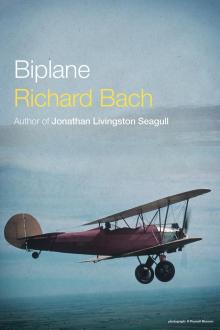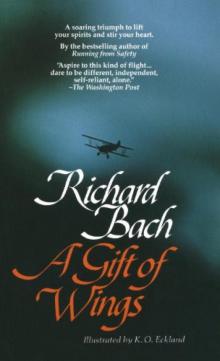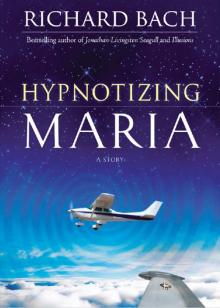- Home
- Richard Bach
A Gift of Wings Page 2
A Gift of Wings Read online
Page 2
“Well, right off the top of my head I remember chugging along there in formation with Shelby Hicks leading the way in his big Stearman biplane, heading for Council Bluffs, last month. And Shelby was flying and Smitty was in the front cockpit navigating—you know the way he does, real careful, with all his distances and headings just down to the exact degree—and all of a sudden the wind catches his map and pow! there it goes up and out of the cockpit like a big green ninety-mile-an-hour butterfly and poor Smitty grabs for it and he can’t quite get it and the look on his face all horror and Shelby is sort of startled first and then he starts laughing. Even from flying alongside I can see Shelby laughing so there’s tears running down inside his goggles and Smitty is disgusted and then in a minute he starts to laughin’ and he points over to me and says, ‘You’re the leader!’ ”
A picture burned in memory because it was wild and fun and shared.
“I remember the time John Purcell and I had to land my plane in a pasture in South Kansas because the weather got bad all at once. All we had for supper was a Hershey bar. We slept under the wing all night, and found some wild berries that we were afraid to eat for breakfast at sunup. And ol’ John saying my airplane made a lousy hotel because some rain got him wet. He’ll never know how close I came to taking off and just leaving him out there in the middle of nowhere, for a while …”
Journeys across the middle of Nowhere.
“I remember the sky over Scottsbluff. The clouds must have gone up ten miles over our head. We felt like darn ants, I tell you …”
Adventures in a country of giants.
“What do I remember? I remember this morning! Bill Carran bet me a nickel he could take off in his Champ in less runway than I’d need in the T-Craft. And I lose, and I can’t figure out why I lose because I always win with that guy, and just when I go to pay him I see he’s snuck a sandbag into my airplane! So he had to pay me a nickel for cheating and another nickel for losing the takeoff when we did it again with the sandbag out …”
Games of skill, with sneaky tricks unplayed since childhood.
“What do I remember? What don’t I remember! But I’m not about to go back and live it over. Too much still to do now.” And an engine starts and the man is gone, dwindling down to nothing against the horizon.
You reach a point, I found, where you begin to know that a pilot does not fly airplanes in order to get somewhere, although he gets to many somewheres indeed.
He doesn’t fly to save time, although he saves that whenever he steps from his automobile into his airplane.
He doesn’t fly for the sake of his children’s education, although the best geographers and historians in class are those who have seen the world and its history in their own eyes, from a private airplane.
He doesn’t fly for economy, although a small used aircraft costs less to buy and run than a big new car.
He doesn’t fly for profit or business gain, although he took the plane to fly Mr. Robert Ellison himself out for lunch and a round of golf and back again in time for the board meeting, and so the Ellison account was sold.
All of these things, so often given as reasons to fly, aren’t reasons at all. They’re nice, of course, but they are only by-products of the one real reason. That one reason is the finding of life itself, and the living of it in the present.
If the by-products were the only purpose for flight, most of today’s airplanes would never have been built, for there are a multitude of annoyances cluttering the path of the lightplane pilot, and the annoyances are acceptable only when the rewards of flight are somewhat greater than a minute saved.
A lightplane is not quite so certain a piece of transportation as an automobile. In poor weather, it is not uncommon to be held for hours, days sometimes, on the ground. If an owner keeps his airplane tied down on the airport grass, he worries with every windstorm and scans every cloud for hail, much as if his airplane were his wife, waiting out in the open. If he keeps his plane in a large hangar, he worries about hangar fires, and thoughtless line-boys smashing other aircraft into his own.
Only when the plane is locked away in a private hangar is the owner’s mind at rest, and private hangars, especially near cities, cost more to own than does the airplane itself.
Flying is one of the few popular sports in which the penalty for a bad mistake is death. At first, that seems a horrible and shocking thing, and the public is horrified and shocked when a pilot is killed committing an unforgivable error. But such are the terms that flying lays down for pilots: Love me and know me and you shall be blessed with great joy. Love me not, know me not, and you are asking for real trouble.
The facts are very simple. The man who flies is responsible for his own destiny. The accident that could not have been avoided through the action of the pilot is just about nonexistent. In the air, there is no equivalent of the child running suddenly from between parked cars. The safety of a pilot rests in his own hands.
Explaining to a thunderstorm for instance, “Honest, clouds and rain, I just want to go another twenty miles and then I promise to land,” is not much help. The only thing that keeps a man out of a storm is his own decision not to enter it, his own hands turning the airplane back to clear air, his own skill taking him back to a safe landing.
No one on the ground is able to do his flying for him, however much that one may wish to help. Flight remains the world of the individual, where he decides to accept responsibility for his action or he stays on the ground. Refuse to accept responsibility in flight and you do not have very long to live.
There is much of this talk of life and death, among pilots. “I’m not going to die of old age,” said one, “I’m going to die in an airplane.” As simple as that. Life, without flight, isn’t worth living. Don’t be startled at the number of pilots who believe that little credo; a year from now you could be one of them, yourself.
What determines whether you should fly, then, is not your business requirement for an airplane, not your desire for a challenging new sport. It is what you wish to gain from life. If you wish a world where your destiny rests completely in your own hands, chances are that you’re a natural-born pilot.
Don’t forget that “Why fly?” has nothing to do with aircraft. It has nothing to do with by-products, the “reasons” so often put forth in those pamphlets to potential buyers. If you find that you are a person who can love to fly, you will find a place to come whenever you tire of a world of TV dinners and people cut from cardboard. You will find people alive and adventures alive and you will learn to see a meaning behind it all.
The more I wander around airports across the country, the more I see that the reason most pilots fly is simply that thing they call life.
Give yourself this simple test, please, and answer these simple questions:
How many places can you now turn when you have had enough of empty chatter?
How many memorable, real events have happened in your life over the last ten years?
To how many people have you been a true and honest friend—and how many people are true and honest friends of yours?
If your answer to all these is “Plenty!” then you needn’t bother with learning to fly.
But if your answer is “Not very many,” then it just might be worth your while to stop by some little airport one day and walk around the place and find what it feels like to sit in the cockpit of a light airplane.
I still think of my salesman acquaintance of the airline flight between San Francisco and Denver. He had despaired of ever finding again the taste of life, at the very moment that he moved through the sky that offers it to him.
I should have said something to him. I should at least have told him of that special high place where a few hundred thousand people around the world have found answers to emptiness.
I’ve never heard the wind
Open cockpits, flying boots, and goggles are gone. Stylized cabins, air conditioners, and sun-shaded windshields are here. I had read and heard this thought fo
r a long time, but all of a sudden it sank in with a finality that was disturbing. We have to admit to the increased comfort and all-weather abilities of modern lightplanes, but are these the only criteria for flying enjoyment?
Enjoyment is the sole reason many of us started to fly; we wanted to sample the stimulation of flight. Perhaps in the back of our minds, as we pushed the high-winged cabin into the sky, we thought, “This isn’t like I hoped it would be, but if it’s flying I guess it will have to do.”
A closed cabin keeps out rain and lets one smoke a cigarette in unruffled ease. This is a real advantage for IFR conditions and chain smokers. But is it flying?
Flying is the wind, the turbulence, the smell of exhaust, and the roar of an engine; it’s wet cloud on your cheek and sweat under your helmet.
I’ve never flown in an open-cockpit airplane. I’ve never heard the wind in the wires, or had only a safety belt between me and the ground. I’ve read, though, and know that’s how it once was.
Are we doomed by progress to be a colorless group who take a roomful of instruments from point A to point B by air? Must we get our thrill of flying by telling how we had the needles centered all the way down the ILS final? Must the joy of being off the ground come by hitting those checkpoints plus or minus fifteen seconds every time? Perhaps not. Of course, the ILSs and the checkpoints have an important place, but don’t the seat of the pants and the wind in the wires have their places too?
There are old-timers with frayed logbooks that stop at ten thousand hours. They can close their eyes and be back in the Jenny with the slipstream drumming on a fuselage fabric; the exhilaration of the wind rush through a hammerhead stall is there any time they call it up. They’ve experienced it.
It isn’t there for me. I started to fly in a Luscombe 8E in 1955, no open cockpits or wires for us new pilots. It was loud and enclosed, but it was above the traffic on the highways. I thought I was flying.
Then I saw Paul Mantz’s Nieuports. I touched the wood and the cloth and the wire that let my father look down on the men who fought in the mud of the earth. I never got that delicious excited feeling by touching a Cessna 140 or a Tri-Pacer or even an F-100.
The Air Force taught me how to fly modern airplanes in a modern efficient manner; no covering the airspeed indicator here. I’ve flown T-Birds and 86s and C-123s and F-100s. The wind hasn’t once gotten to my hair. It has to get through the canopy (“CAUTION—Do not open above 50 knots IAS”), then through the helmet (“Gentlemen, a square inch of this fiberglass can take an eighty-pound shock force”). An oxygen mask and a lowered visor complete my separation from possible contact with the wind.
That’s the way it has to be now. You can’t fight MIGs with an SE-5. But the spirit of the SE-5 doesn’t have to disappear, does it? When I land my F-100 (chop the power when the main gear touches, lower the nose, pull the drag chute, apply brakes till you can feel the antiskid cycle), why can’t I go to a little grass strip and fly a Fokker D7 airframe with one hundred fifty modern horses in the nose? I’d pay a lot for the chance!
My F-100 will clip along at Mach One plus, but I don’t feel the speed. At forty thousand feet, the drab landscape creeps under the droptank as if I were in a strictly enforced twenty-five mile speed zone. The Fokker will do an indicated one hundred ten miles per hour, but it will do it at five hundred feet and in open air, for the fun of it. The landscape wouldn’t lose its color to altitude, and the trees and bushes would blur with speed. My airspeed indicator wouldn’t be a dial with a red-line somewhere over Mach One, it would be the sound of the wind itself, telling me to drop the nose a little and get ready to hop on the rudders, for this plane doesn’t land itself.
“Build a World War I airframe with a modern engine?” you ask. “You could get a four-place plane for the money!”
But I don’t want a four-place plane! I want to fly!
I shot down the Red Baron, and so what
It was not a Mitty dream. It was no fantasy at all. That was a hard roaring black-iron engine bolted to the firewall ahead of my boots, those were real Maltese-crossed wings spanning out over my cockpit, that was the same ice-and-lightning sky I had known most of my life long, and over the side it was a long fall to the ground.
Now, down there in front of me, was a British SE-5 fighter plane, olive drab with blue-white-red roundels on the wings. He hadn’t seen me. It all felt exactly the way I had known it would feel, from reading the yellow old war-books of flight. Exactly that way.
I stepped hard on the rudder bar, pulled the joystick across the cockpit and rolled down on him, tilting the world about me in great sweeping tilts of emerald earth and white-flour cloud, and blasting slants of blue wind across my goggles.
While he flew along unaware, the poor devil.
I didn’t use the gunsight because I didn’t need it. I lined the British airplane between the cooling jackets of the two Spandau machine guns on the cowl in front of me, and pressed the firing button on the stick.
Little lemon-orange flames licked from the gun muzzles with a faint pop-pop over the storm of my dive. Yet the only move the SE made was to grow bigger between my guns.
I did not shout, “Die, Englander pig-dog!” the way the Hun pilots used to shout in the comic books.
I thought, nervously, You’d better hurry up and burn or it’ll be too late and we’ll have to do this all over again.
In that instant a burst of night swallowed the SE. It leaped up into an agonized snap roll, clouting black from its engine, pouring white fire and oil smoke behind it, emptying junk into the sky.
I dove past him like a shot, tasting the acid taste of his fires, twisting in my seat to watch him fall. But fall he did not. Smoke gushing dark oceans from his plane, he wobbled half-turn through a spin, pointed straight down at me, and opened fire with his Lewis gun. The orange light of the gun barrel flickered at my head, twinkling in dead silence from the middle of all that catastrophe. All I could think was, Nicely done. And that this must have been just the way it was.
The Fokker snatched into a vertical climb in the same instant that I hit the switch labeled SOOT (foof! from beneath my engine) and the one next to it labeled SMOKE. The cockpit went dim in roiling yellow-black which I breathed in tiny gasps. Right rudder to push the airplane into a falling slide to the right, full back-stick to spin it. One turn … two … three … the world going round like a runaway Maytag. Then a choking recovery into a diving spiral, followed every foot by that river of wicked fog.
Presently the cockpit cleared and I recovered to level flight, a few hundred feet above the green farms of Ireland. Chris Cagle, flying the SE-5, turned a quarter mile away, rocking his wings in signal to join in formation and fly home.
As we crossed the trees side by side and touched our tailskids to the wide grass of Western Aerodrome, I counted that this had been an eventful day. Since dawn I had shot down one German and two British airplanes, had myself been shot down four times—twice in an SE-5, once in a Pfalz, once in this Fokker. It was a lively introduction to the way that a movie pilot earns his keep, and there was a month more of it to come.
The film was Roger Corman’s Von Richthofen and Brown, an epic featuring a fair amount of gore, some sex, a tampering with history, and twenty minutes of aerial footage that several living pilots nearly stopped living to produce. The gore and sex and history were make-believe, but the flying, as flying always is, was the real thing. Chris and I learned that first day in the air what every movie pilot since Wings has known: nobody has “ever told the airplanes that this is all in fun. The aircraft still stall and spin, they’ll have real mid-air collisions if you let them do it. No one else but pilots can understand this.
The camera tower was an excellent example. Our camera tower was a place built of telephone poles, a platform thirty feet above a knob of ground called Pigeon Hill. The cameraman and two assistants would climb to that platform every morning in sweet assurance that since this was only a film, they would live to climb down from the tower
every afternoon. They had a trust in Chris and me and Jon Hutchinson and the dozen Irish Air Corps pilots that was beyond blind … the cameramen acted as if the aircraft diving down on them for head-on shots, guns blazing, were already pussycats safe on film.
It is ten a.m. We are a flight of two Fokker D-7s and two SE-5s. The engines and the wind are clattering about our heads and down there off our wingtops is the lonely lump of Pigeon Hill, with its tower on top and its cameramen on their platform.
“We want a tail chase this morning,” they tell us on the radio. “An SE in front, a Fokker after him, another SE, and the other Fokker. You got that?”
“Roj.”
“Come on close to the tower, please, then bank up on one wing and turn around us so we can see the tops of your airplanes. Close as you can to each other, please.”
“Roj.”
So here we go, from a thousand feet above the ground we fall into tight line-astern formation, the airplane ahead looming gigantic in our windscreen. Here’s the dive at the tower, that tiny pyramid down there.
“Action! This is a take!”
The SE in the lead jinks violently back and forth, aiming for the tower and the ground. We follow him in the Fokker, firing short bursts of oxyacetylene from our fake guns, aware that another SE is close under our tail, firing, and that the other Fokker is under his. From moment to moment we catch the propwash of the plane ahead, which slams us up into a roaring bank that takes full opposite aileron and rudder to control. This is no problem, with room beneath us. But the room dwindles fast, and in a few seconds the camera tower is a pretty big thing, then a monster, and the cameraman is wearing a white shirt and a blue jacket and a red-and-blue scarf and the SE banks hard around the tower and we’re in the WASH AND STICK RUDDER LOOKOUT WE’RE GONNA ROLL RIGHT INTO …

 Illusions: The Adventures of a Reluctant Messiah
Illusions: The Adventures of a Reluctant Messiah Biplane
Biplane Stranger to the Ground
Stranger to the Ground A Gift of Wings
A Gift of Wings Holidays on Ice
Holidays on Ice Hypnotizing Maria: A Story
Hypnotizing Maria: A Story Jonathan Livingston Seagull
Jonathan Livingston Seagull The Bridge Across Forever: A True Love Story
The Bridge Across Forever: A True Love Story Nothing by Chance
Nothing by Chance Illusions
Illusions Jonathan Livingston Seagull: The New Complete Edition
Jonathan Livingston Seagull: The New Complete Edition Hypnotizing Maria
Hypnotizing Maria Illusions II: The Adventures of a Reluctant Student (Kindle Single)
Illusions II: The Adventures of a Reluctant Student (Kindle Single)